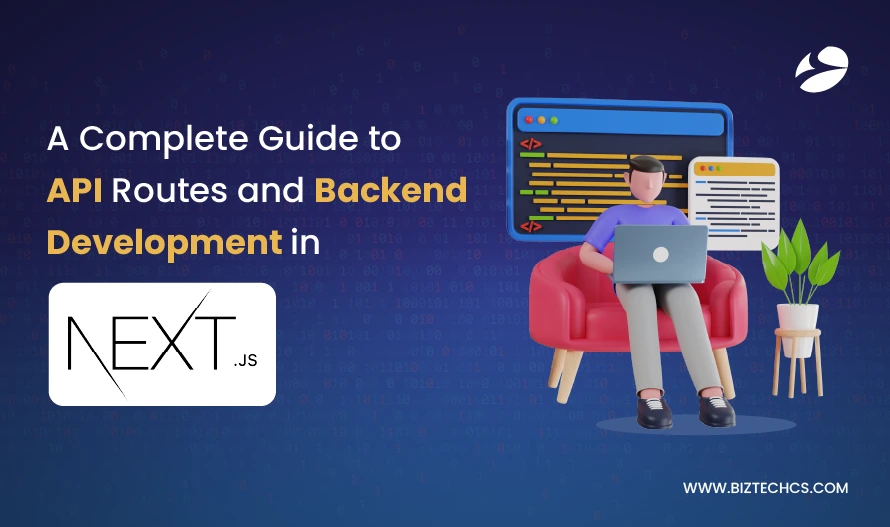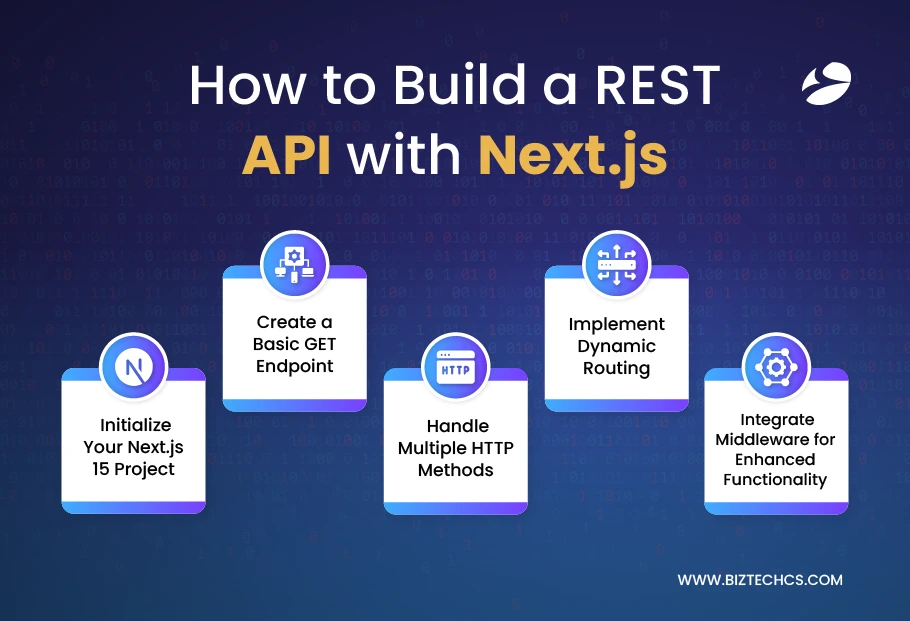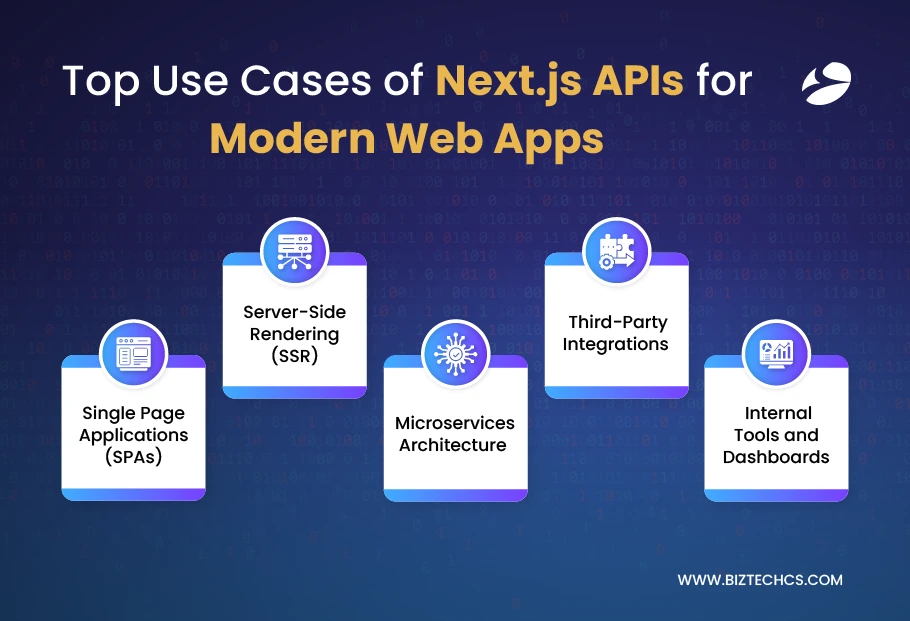4217
How to Build APIs with Next.js: Developer Guide
10 min read
4217
10 min read
Table Of Content

Developers commonly used separate front-end and back-end tools, which added complexity, slower delivery, and disjointed codebases. The Next.js framework alters this by providing a more centralized solution.
Since the introduction of Next.js 15, it has become much simpler to handle frontend views and backend logic in one project. But often, a beginner’s mistake is starting development without a complete grasp of how API routes in Next.js work.
Mistakes usually involve confusing route handling, neglecting security levels, or forgetting platform limitations. This tutorial describes how to create a REST API with Next.js in a well-organized and secure manner.
Each step responds to definite requirements for dependability, performance, and scalability. This material provides hands-on guidance for individuals seeking to utilize Next.js API routes efficiently without falling into common traps—something a skilled Next.js development company often supports.
Interchanging the isolated frontend and backend repositories generally introduces latency and adds complexity. Next.js 15 supports API routes, so backend activities can now be handled inside the same project.
Such routes are to be declared inside the new app/api directory and keep things nicely and straightforward structured. One would no longer require separate backend configuration to set up, cutting the config time significantly.
This method makes the Next.js API configuration a lot simpler to maintain and reduces integration errors.

Start by creating a new Next.js project with the –api flag, which initializes the project with API route examples:
npx create-next-app@latest my-next-app –api
This creates a project structure with the app/api directory, where you define your API routes.
To install a basic GET endpoint, create a new file at app/api/hello/route.ts with the following code:
export async function GET(request: Request) {
return new Response(‘Hello, Next.js 15!’);
}
Accessing /api/hello will now respond with “Hello, Next.js 15!”.
Next.js 15 lets you declare multiple HTTP methods in the same route file. To support both GET and POST requests, for example, you can organize your route.ts as below:
export async function GET(request: Request) {
// Handle GET request
return new Response(‘This is a GET request’);
}
export async function POST(request: Request) {
const data = await request.json();
// Process POST data
return new Response(`Received data: ${JSON.stringify(data)}`);
}
This configuration allows your API route to handle things differently depending on the HTTP method employed.
Dynamic. Dynamic routes are useful when processing requests with variable parameters, like retrieving a particular blog post by its ID. To make a dynamic route, have some of the following structure:
Here’s how you can define the GET handler in route.ts:
const blogs = [
{ id: ‘1’, title: ‘First Blog Post’ },
{ id: ‘2’, title: ‘Second Blog Post’ },
{ id: ‘3’, title: ‘Third Blog Post’ },
];
export async function GET(request: Request, context: { params: { id: string } }) {
const { id } = context.params;
const blog = blogs.find((b) => b.id === id);
if (blog) {
return new Response(JSON.stringify(blog), {
status: 200,
headers: { ‘Content-Type’: ‘application/json’ },
});
} else {
return new Response(JSON.stringify({ error: ‘Blog not found’ }), {
status: 404,
headers: { ‘Content-Type’: ‘application/json’ },
});
}
}
With this configuration, a request for /api/blog/2 will respond with the blog post for ID 2.
Middleware functions can be utilized to add features such as authentication, logging, or request transformations. In Next.js 15, you could create middleware by creating a middleware.ts file inside the app directory. Here’s a basic example of a logging middleware:
import { NextRequest, NextResponse } from ‘next/server’;
export function middleware(request: NextRequest) {
console.log(`Request made to: ${request.url}`);
return NextResponse.next();
}
This middleware writes the URL of every incoming request to the console. You can build on top of this with more sophisticated logic if necessary.

Next.js API routes assist in retrieving data without reloading the whole page. This maintains a smooth user interface and decreases server load. All the requests occur in the background, keeping the app interactive and fast.
Data is fetched on the server side on page load with the Next.js API. This makes the first view appear faster. It also improves SEO, as search engines obtain the content instantly. The user does not wait for frontend scripts to fetch data, which increases speed and visibility.
Most teams utilize microservices for various features. Rather than calling each one from the browser, they link them through a central Next.js API. This keeps the front end organized and provides error handling in one location. Updates in one service don’t impact the rest of the app.
Outside services such as Stripe or GitHub push data with webhooks. Next.js API routes can process these incoming requests. That means you don’t require a dedicated server. Payments, alerts, or updates can be processed directly. The integration remains easy and secure.
Some capabilities should be reserved for internal teams. Next.js API routes can fuel tools such as admin dashboards or reporting systems. These routes remain private and may encompass authentication. It enables teams to work safely. And it all runs from the same codebase.
Next.js enables developers to create APIs in the same project as the frontend. For small to medium-sized apps, this is usually enough.
You can manage things like form processing, authentication, or database access. No additional backend server is needed, making the architecture simple and inexpensive.
The pattern complements platforms such as Vercel or AWS Lambda. Each API route gets deployed as an individual function, allowing the backend to scale automatically depending on traffic. You don’t have to manage servers, making it a good fit for apps with uneven traffic.
Applications that need complex background processing or lengthy tasks may reach their limits. Next.js serverless functions have timeouts. A traditional backend might be a better choice if you’re working with video processing, real-time messaging, or job queues.
Nevertheless, Next.js is suitable for most web applications’ short, task-oriented backend tasks. The trick is to know your limits.
Front-end and back-end logic reside in one codebase, enhancing collaboration and accelerating development. Shared code, such as validation rules, is simpler to maintain and makes it easier to onboard new developers. Everything remains in sync.
Simple does not equal sloppy. APIs should still be secured with authentication and proper validation. It’s also a good idea to keep route logic tidy. Keeping to a clear structure avoids technical debt. A well-designed API is simpler to test, scale, and maintain.
Secure sensitive endpoints start with good authentication. Token-based techniques like JWT guarantee that only authenticated users can access protected routes. Every request must present a valid token, or it is rejected.
Frameworks such as NextAuth.js provide a secure and effective means of handling authentication flows in session-based applications. They handle most of the complexity and play nicely with the Next.js API pattern.
Unvalidated input is the most popular avenue for security holes. Every API endpoint must have validation logic in place to validate the structure and type of the incoming data. Basic schema validation tools can intercept errors early on and keep bad or invalid requests from hitting the core logic.
This protects the application and makes debugging and testing more accurate. Good validation feeds directly into data integrity and system stability.
Rate limiting must be enforced to safeguard APIs against abuse. It limits the number of times a user or an IP address can hit endpoints within a specified time frame. This prevents brute-force attacks and avoids unnecessary server load.
Libraries and middleware can enforce limits without impacting performance. Fair usage policies are advantageous for application security and infrastructure efficiency.
Sensitive information like API keys and secrets must never be hardcoded into source files. Environment variables provide a secure alternative by leaving this information out of the codebase. Variables are loaded during runtime and may be set up differently in different development, staging, and production environments.
Applying environment variables diminishes the likelihood of accidental exposure via version control. It’s an integral component of having a secure and compliant development process.
Good error handling is essential to the security and reliability of API routes. Rather than cryptic or unhelpful responses, every error should provide a clear status code and message. This behavior helps developers while debugging and enhances the experience for any system that is communicating with the API.
It also prevents sensitive information from being leaked through error messages. Structured error responses are key to creating a secure API route in Next.js.
In a traditional setup, frontend and backend personnel work in different environments, delaying projects and creating communication gaps. Next.js places frontend and backend logic in one codebase.
This facilitates collaboration without endless handoffs between teams. Developers can move fast without juggling between frameworks, which makes project management and iteration more efficient.
The newer stacks require quite a few third-party tools to optimize performance. Next.js, however, offers features like code splitting by default and image optimization.
In other words, watching the site load into the browser becomes an awkward funeral march instead of a jolly fugue with these slow page loads. Applications also do not feel sluggish as new bells and whistles are added. Everything, in turn, spells user experience and user retention.
Search engines always rank sites poorly when the content is rendered on the client side only. Next.js’s big selling point is its native support for server-side rendering (SSR) and static site generation (SSG).
These rendering methods also ensure that content is available to search engines at page load. Pages, therefore, are more accurately indexed, leading to better rankings and, ultimately, better organic traffic.
Next.js, through a mature and active community, also has a rich plugin ecosystem. Seminars, documentation, examples, and numerous shared remedies are aplenty. This guarantees that development teams can identify and troubleshoot problems faster instead of reinventing the wheel.
These community condensates prove ideal for accelerating the feature set rollout, making development cycles easier to predict and with less room for errors.
New applications usually demand a combination of rendering approaches. The Next.js framework enables selective application of SSR, SSG, and client-side rendering depending on the requirements of individual pages. Flexibility in this way enables teams to strike a balance between performance and complexity.
Numerous companies hire a Next.js development company for setup, and subsequently hire a Next.js development agency for scaling solutions. This flexibility helps both short-term and long-term development.
Vercel is natively built to deploy serverless functions made with the Next.js framework. API routes found inside the app/API folder are instantly provisioned as serverless endpoints. Deployments require minimal configuration, allowing projects to be quickly onboarded.
All scaling and routing management from Vercel happens without further manual effort, making the platform a strong default temptation for more teams using Next.js API routes.
API routes deployed to AWS Lambda through the Serverless Framework allow use cases requiring more involved control. Each route can be mapped to a specific Lambda function with this setup. Other AWS services like DynamoDB or S3 can be integrated with this service, too.
Custom configurations are available for memory, timeouts, and environment variables. This is suited for applications needing a stricter degree of infrastructure control.
Platforms like Netlify or Azure Functions also support serverless deployments. Each platform requires small variations in route setup or file structure. API routes written in Next.js are thus adaptable for these services. Ensuring their compatibility across platforms establishes flexibility in the choice of hosting provider, avoiding being locked down to a vendor for the long haul.
Setting up CI/CD pipelines provides consistent and automated deployments. These are triggered by code changes, spawning tests, the build process, and production deployment. This process reduces human error and shortens development cycles.
These tools are GitHub Actions, GitLab CI, and Bitbucket Pipelines. A solid CI/CD pipeline means faster and more stable releases.
Performance and reliability are monitored during deployment and thus studied by the tool. Tools such as Sentry and LogRocket offer insight into errors and request behavior in real time. So, should issues arise, they can be accounted for before they affect an end user.
Analytics track usage trends and performance metrics, also. This visibility is necessary for technical and business improvements.
Serverless platforms autoscale with traffic. Yet it is paramount to know limitations such as cold starts, execution timeouts, and memory usage. Efficient design helps reduce both response time and resource usage.
By designing our functions to execute faster, we will spend less money and increase reliability. This is also the time to plan for high loads and ensure that API routes remain responsive.
One of the benefits of creating API routes on Next.js 15 is that it eases full-stack development. The next/API folder, located in the front end, sets an efficient link between frontend and backend logic.
Developers cope with GET, POST, and dynamic routing systems in a jiffy. Middleware, validation, and error handling give you cover to ensure a secure API route in Next.js. These routes cater to SPAs, SSR, internal tools, and third-party integrations. The structured approach is the best way to build a scalable REST API on Next.js.
A Next.js development company or Next.js development agency supports teams using Next.js for fast-running, reliable, and scalable solutions. The Next.js API routes show that Next.js can be a good backend if clearly defined with boundaries and planning for many modern applications.
An API route in Next.js is a backend endpoint created inside the same project as your frontend. It lets you handle requests like GET and POST without using a separate server.
Yes, you can build a REST API using the app/api directory in Next.js 15. It supports multiple methods, dynamic routes, and serverless deployment.
Next.js works well for short and simple backend tasks. It is not ideal for long-running processes or complex systems.
Secure your routes with authentication, input validation, and environment variables. Also, handle errors properly and avoid hardcoding sensitive data.
A Next.js development company can help set up projects correctly and avoid common mistakes. It also saves time by using best practices from the start.

Artificial Intelligence (AI)
81
By Biztech Editor

Odoo
119
By Uttam Jain

Artificial Intelligence (AI)
91
By Biztech Editor